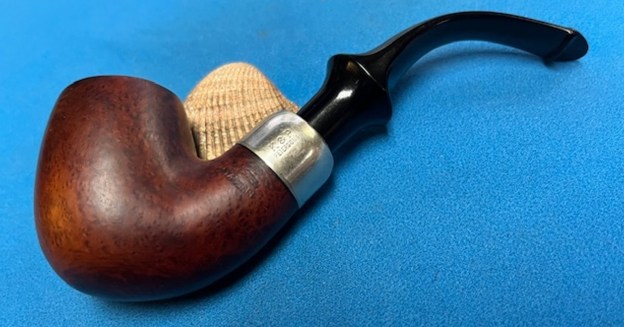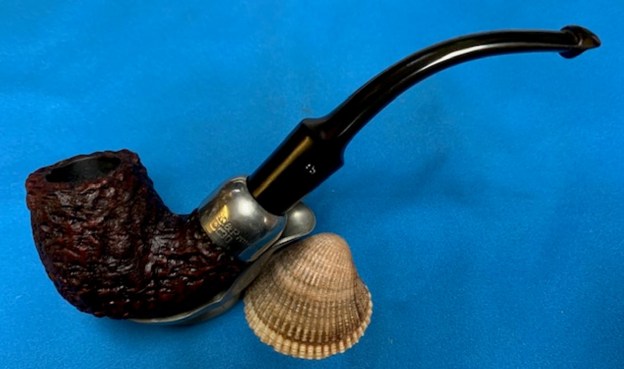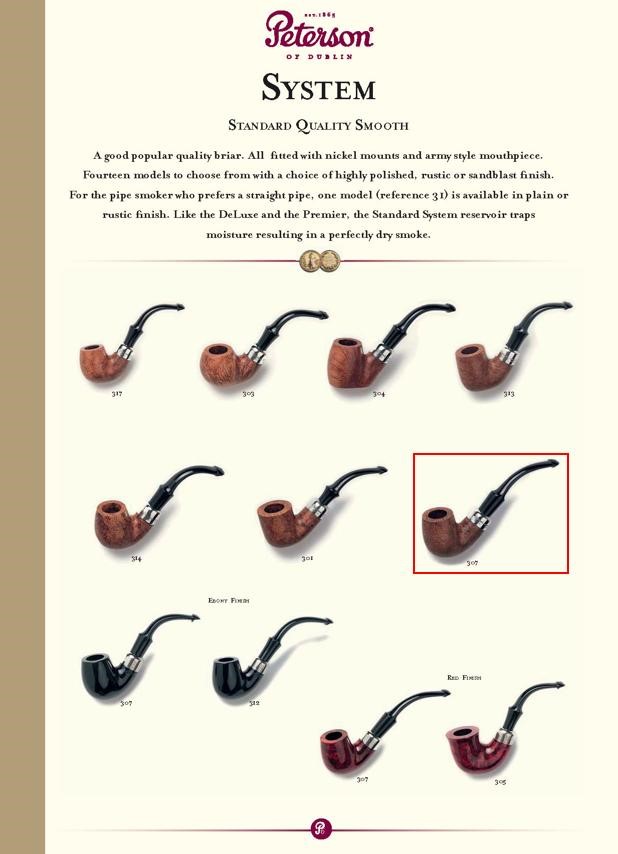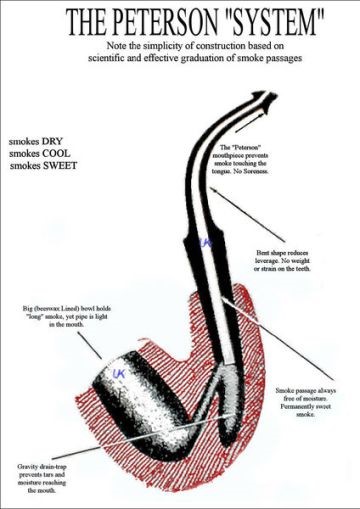Blog by Steve Laug
The next pipe on the work table is Smooth Peterson’s System pipe that we purchased somewhere along the way. Neither Jeff or I remember where we picked it up. It is an interesting system pipe with some light road rash on the right side of the bowl and a chip out of the outer edge of the bowl on the right side. It was stamped Peterson’s [arched over] System [arched over] Standard on the left side of the shank. It is a bit faint but it is readable. On the right side it is stamped Made in the Republic of Ireland (in three lines) [over] the shape number 307. The nickel ferrule on the shank end was oxidized and is stamped on the left side K&P [over] Petersons. Jeff had cleaned and reamed the bowl somewhere along the way and the finish is very clean. The top and edges of the rim were clean but showed some damage. The inner edge was out of round and the outer edge had a chip on the right side. The stem was the wrong stem for the pipe. It was not a Peterson’s style P-Lip but rather a Wellington style with the airway exiting on the end of the stem. Jeff had cleaned it up as well and it did not look too bad. I would need to restem it with a proper stem. I took photos before I started working on it today.
 I took a photo of the bowl and rim top to show the condition of the bowl and the top of the rim and the edges of the bowl. The rim top had darkening and damage and the inner edge was out of round. The outer edge on the right side showed a chip. I took photos of the stem it came with as well. You can see the tooth chatter and marks on the stem surface and wear on the edges of the button. You can also see the exit of the airway on the stem end rather than the to of the P-lip.
I took a photo of the bowl and rim top to show the condition of the bowl and the top of the rim and the edges of the bowl. The rim top had darkening and damage and the inner edge was out of round. The outer edge on the right side showed a chip. I took photos of the stem it came with as well. You can see the tooth chatter and marks on the stem surface and wear on the edges of the button. You can also see the exit of the airway on the stem end rather than the to of the P-lip. I took photos of the stamping on the side of the shank. The stamping was faint but readable as you can see from the photos. It read as noted above. The nickel ferrule on the shank end is stamped on the top and left side K&P [over] Petersons. I took the stem off the shank and took a photo of the parts. You can see how the stem is definitely not a Peterson’s P-Lip.
I took photos of the stamping on the side of the shank. The stamping was faint but readable as you can see from the photos. It read as noted above. The nickel ferrule on the shank end is stamped on the top and left side K&P [over] Petersons. I took the stem off the shank and took a photo of the parts. You can see how the stem is definitely not a Peterson’s P-Lip.
 I have included the information on the shape number on this pipe that I picked up on researching the previous pipes. It is a large looking 307 System Standard. I have included a page from a Petersons Catalogue that I have on rebornpipes (https://rebornpipes.com/tag/peterson-hallmark-chart/). I have put a red box around the 307 shown in the catalogue page shown below. That should give a clear picture of the size and shape of the pipe.
I have included the information on the shape number on this pipe that I picked up on researching the previous pipes. It is a large looking 307 System Standard. I have included a page from a Petersons Catalogue that I have on rebornpipes (https://rebornpipes.com/tag/peterson-hallmark-chart/). I have put a red box around the 307 shown in the catalogue page shown below. That should give a clear picture of the size and shape of the pipe. 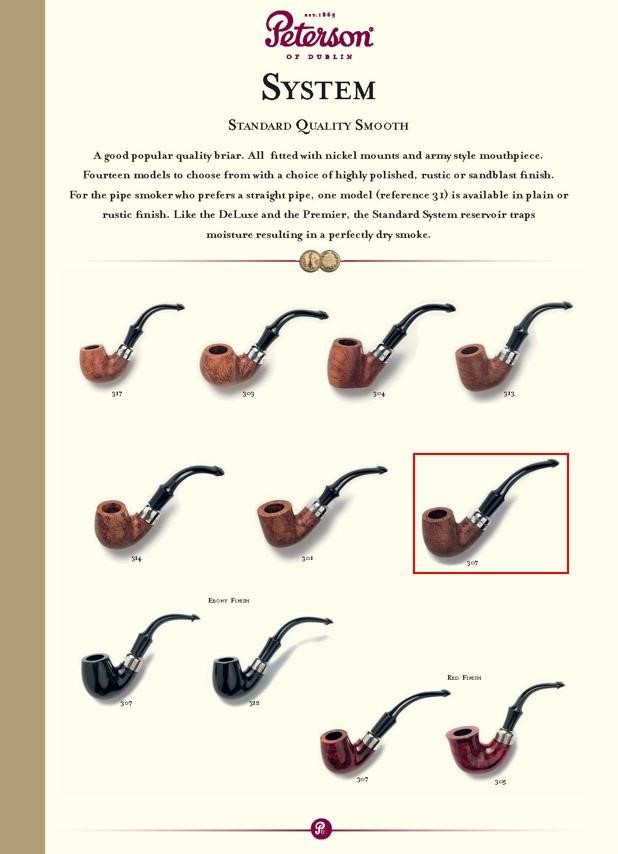 I am also including the information from Pipedia’s article on Peterson pipes. It is a great read in terms of the history of the brand (https://pipedia.org/wiki/Peterson). I have included a bit of the pertinent history here.
I am also including the information from Pipedia’s article on Peterson pipes. It is a great read in terms of the history of the brand (https://pipedia.org/wiki/Peterson). I have included a bit of the pertinent history here.
1950 – 1989 The Republic Era – From 1950 to the present time, the stamp for this era is “Made in the Republic of Ireland” in a block format generally in three lines but two lines have been used with or without Republic being abbreviated.
During the 1950’s and 60’s the Kapp & Peterson company was still in the ownership of the Kapp family. However 1964 saw the retiral of the company Managing Director Frederick Henry(Harry) Kapp.
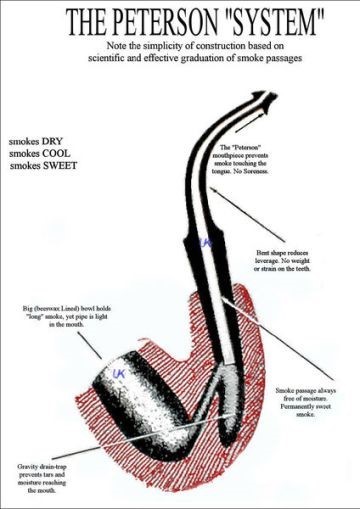 Pipedia also included a section of information on the System pipes including a diagram of the systems look (https://pipedia.org/wiki/Peterson#Republic_Era_Pipes). I quote a section of the article in part and include a link to another article on Pipedia on the System pipe.
Pipedia also included a section of information on the System pipes including a diagram of the systems look (https://pipedia.org/wiki/Peterson#Republic_Era_Pipes). I quote a section of the article in part and include a link to another article on Pipedia on the System pipe.
The Peterson System pipes are the standard bearers of the Peterson pipe family, famous for the excellent smoking pleasure they provide. Often imitated but never equaled, the Peterson System smokes dry, cool and sweet, thanks to the scientific effectiveness of the original design. The heart of the System is the unique graduated bore in the mouthpiece. This makes the suction applied by the smoker 15 times weaker by the time it reaches the tobacco chamber. The result is that all the moisture flows into the reservoir and, thus cannot reach the smoker’s mouth. The Peterson Lip further enhances the effectiveness of the graduated bore by directing the flow of smoke upwards and away from the tongue. This achieves a uniquely even distribution of smoke and virtually eliminates any chance of tonguebite or bitterness. Furthermore, the shape is contoured so that the tongue rests comfortably in the depression under the opening. Each “PLip” mouthpiece is made from Vulcanite. For the Peterson System pipes to work properly, the stem/tenon has to have an extension, the tip of which will pass by the draft hole from the bowl and into the sump. Upon the smoker drawing in smoke, this extension then directs the smoke down and around the sump to dispense a lot of the moisture before the smoke enters the extension and stem. On the System Standards and other less expensive systems, this extension with be made of Vulcanite turned integrally with the stem. On the more expensive System pipes this extension will be made of metal which screws into the Vulcanite stem. This extension on the earlier pipes will be of brass and the newer pipes will be of aluminium. Most smokers not knowing this function of the metal extension, assumes that it is a condenser/stinger and will remove it as they do with the metal condensers of Kaywoodie, etc. Should you have a System pipe with this metal extension, do not remove it for it will make the System function properly and give you a dryer smoke (https://pipedia.org/wiki/A_closer_look_at_the_famous_Peterson_Standard_System_Pipe).
With that information in hand I knew what I was dealing with in terms of the stamping and the age of this pipe. I knew from the information that the pipe was made during the Republic Era between 1950 and 1989. My guess is that the pipes is a 1960s era System pipe. Now it was time to work on the pipe.
I removed the incorrect stem and replaced it with a correct P-Lip stem for a 307 that I had here in my box of stems. It has a little larger flare than I remembered but it still fit better and looked very good. I took photos of the pipe with the new stem.

 I worked over the rim top and the inner and outer edge of the bowl with a folded piece of 220 grit sandpaper. I was able to smooth out the damage on the inner edge and remove the nicks on the top surface. The outer edge looked better though I left one nick on the right outer edge as a part of the story of the pipe.
I worked over the rim top and the inner and outer edge of the bowl with a folded piece of 220 grit sandpaper. I was able to smooth out the damage on the inner edge and remove the nicks on the top surface. The outer edge looked better though I left one nick on the right outer edge as a part of the story of the pipe. I polished the briar with micromesh sanding pads – dry sanding it with 1500-12000 git sanding pads. I wanted remove as many of the light scratches in the briar as I could. I wiped it down with a damp cloth after each sanding pad.
I polished the briar with micromesh sanding pads – dry sanding it with 1500-12000 git sanding pads. I wanted remove as many of the light scratches in the briar as I could. I wiped it down with a damp cloth after each sanding pad.




 I worked some Before & After Restoration Balm into the surface of the briar with my fingertips to clean, enliven and protect the briar. I let the balm sit for 15 minutes and then buffed with a cotton cloth to raise the shine. The photos show the bowl at this point in the restoration process.
I worked some Before & After Restoration Balm into the surface of the briar with my fingertips to clean, enliven and protect the briar. I let the balm sit for 15 minutes and then buffed with a cotton cloth to raise the shine. The photos show the bowl at this point in the restoration process.

 With briar polished with the Restoration Balm I moved onto the metal. I polished the nickel ferrule with a jewellers cloth to raise the shine and to protect the ferrule from further oxidation.
With briar polished with the Restoration Balm I moved onto the metal. I polished the nickel ferrule with a jewellers cloth to raise the shine and to protect the ferrule from further oxidation.
 I took photos of the new stem before I put it in the shank. It is a new stem so it is quite shiny. It will look great on the pipe.
I took photos of the new stem before I put it in the shank. It is a new stem so it is quite shiny. It will look great on the pipe. I am excited to be on the homestretch. I look forward to the final look when the Republic Era Peterson System Standard 307 is put back together, polished and waxed. I put the bowl and the new stem back together. I polished the bowl and stem with Blue Diamond to polish the briar and the vulcanite. I gave the bowl and the stem multiple coats of carnauba wax. I buffed the pipe with a clean buffing pad to raise the shine. I hand buffed it with a microfiber cloth to deepen the shine. The pipe polished up pretty nicely. Grain stands out nicely as do the marks of the pipe journey. The shiny black vulcanite stem is a beautiful contrast to the browns of the bowl and thick shank and nickel ferrule. This Peterson’s System Standard 307 Bent Billiard was another fun pipe to work on. It really is a quite stunning piece of briar whose shape follows the flow of the briar. The pipe is tactile in the hand and should feel great as it is warmed up when smoking. The finished pipe is shown in the photos below. The dimensions of the pipe are Length: 6 inches, Height: 2 inches, Outside diameter of the bowl: 1 ¼ inches, Chamber diameter: 7/8 of an inch. The weight of the pipe is 2.47 ounces/71 grams. I will be putting it on the rebornpipes store in the Irish Pipemakers Section if you would like to add it to your rack and carry on the previous pipeman’s legacy. This is an interesting estate to bring back to life.
I am excited to be on the homestretch. I look forward to the final look when the Republic Era Peterson System Standard 307 is put back together, polished and waxed. I put the bowl and the new stem back together. I polished the bowl and stem with Blue Diamond to polish the briar and the vulcanite. I gave the bowl and the stem multiple coats of carnauba wax. I buffed the pipe with a clean buffing pad to raise the shine. I hand buffed it with a microfiber cloth to deepen the shine. The pipe polished up pretty nicely. Grain stands out nicely as do the marks of the pipe journey. The shiny black vulcanite stem is a beautiful contrast to the browns of the bowl and thick shank and nickel ferrule. This Peterson’s System Standard 307 Bent Billiard was another fun pipe to work on. It really is a quite stunning piece of briar whose shape follows the flow of the briar. The pipe is tactile in the hand and should feel great as it is warmed up when smoking. The finished pipe is shown in the photos below. The dimensions of the pipe are Length: 6 inches, Height: 2 inches, Outside diameter of the bowl: 1 ¼ inches, Chamber diameter: 7/8 of an inch. The weight of the pipe is 2.47 ounces/71 grams. I will be putting it on the rebornpipes store in the Irish Pipemakers Section if you would like to add it to your rack and carry on the previous pipeman’s legacy. This is an interesting estate to bring back to life.
As always, I encourage your questions and comments as you read the blog. Thanks to each of you who are reading this blog. Remember we are not pipe owners; we are pipe men and women who hold our pipes in trust until they pass on into the trust of those who follow us.
















